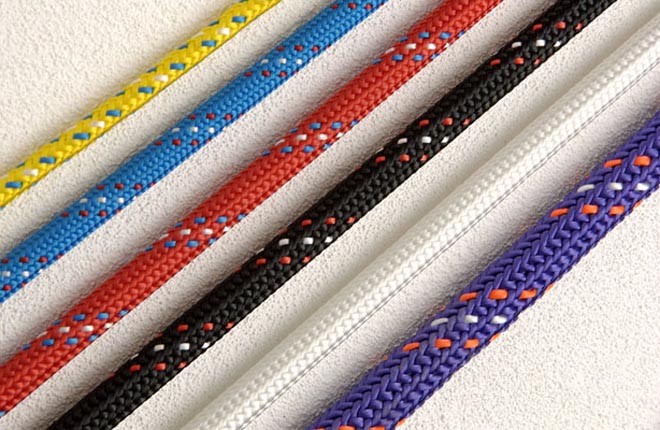Respect the rope- Dyneema lifeline guidelines
by Colligo Marine on 9 Nov 2011

Dyneema - hints on its use SW
Courtesy of Colligo Marine, we here present the first of a series of educational documents that highlight the usage of Dyneema for all aspects of rigging on a sailboat. This Respect the Rope series will discuss the many uses of Dyneema with an emphasis on getting the most value from this great product, showing key attributes and limitations. The first concerns lifeline guidelines:
1: Size lifelines as large as possible, to get at least 2 times more breaking strength as the steel the Dyneema is replacing.
The beauty of Dyneema is its incredible strength, use this to your advantage. Maximize the factor of safety you have on your lifelines by using the largest line possible. This will give you the largest window of opportunity to deal with
issues like chafe and UV damage. At 2 times the strength of the previous steel, you can cut 1/2 way thru the line and still be as strong as the steel was. 3 times the strength will buy you even more time.
2. Eliminate potential chafe issues:
Eliminate any sharp edges especially at the stanchion pass thru holes. You can also add a sacri?cial cover to the line as it passes thru the stanchions for extra chafe resistance with a sacri?cial cover. If there are areas where you
anticipate extra protection is needed such as where a spinnaker sheet might rub than you can also add extra protection there. We provide Dyneema sleeving material for this or you can simply wrap the line with some rigging
tape in the affected areas.
3. All end ?ttings should have a minimum 5/1 bending ratio (minimum 80% break strength maintained at 5/1 but break strength drops off fast if the ratio is less):
Using the proper end ?tting is important as a 5/1 bending ratio maintains a minimum of 80% of the mean breaking load of the line (Most of our pull test results are 100% or more with our line terminators). Our pull testing has
shown that, with a proper splice, the Dyneema line breaks at the bend. A smaller radius means less breaking strength. It is easy to be tempted to just splice the lifeline material to the pulpit or pushpit but this will decrease the life of your line signi?cantly. A small bending radius can be very dangerous as the compounding factors of UV damage, a tight bending radius, and any chafe issues can severely decrease the line strength. Use our line terminators (min 5/1bending ratio) or a thimble and lash to the pulpit/pushpit and keep an eye on the lashing line and replace when needed, this will make your lifelines last longer and save you money in the long run.
4. Inspect regularly for chafe and other issues:
Another big advantage of Dyneema line is that it can be easily inspected. Synthetic lifelines do need to be inspected often but this is relatively easy as damage on your line gets a hairy look to it when it is abraided. Each Dyneema
strand is made up of thousands of minute ?bers and as these break they give a hairy look to the line in the area in question. Most of the time you will notice any chafe issues during normal activity on the boat and if sized correctly you will have some time to protect or replace the line.
5. Understand that your high factor of safety buys you some time in replacing the line:
The high strength of Dyneema is the big enabler for using it in practice. With at least a 2 times strength (from steel) that is needed for the application you will have some time to deal with issues like chafe and even UV degradation.
Knowing that your line can be cut at least halfway thru and still have the strength you need gives you a good warm and fuzzy feeling. Use the largest line diameter that is feasible and Maximize your factor of safety.
A word about UV resistance:
Studies and lab testing have indicated that Dyneema ?bers will initially see some damage from UV rays but then become relatively opaque to UV. This means that the material forms a protective layer and the rate of UV damage goes down to almost nothing after a short time in the sun. This is another reason to give yourself a large strength factor of safety.
Why we use Dynex Dux for lifelines:
We use 5 mm Dynex Dux for lifelines. It is heat stretched Dyneema SK-75. Dynex Dux is much stronger than normal Dyneema (11,000 lbs-f Breaking Strength) but, more importantly, even more chafe resistant.
A note to chafe resistance of Dynex Dux:
We use ceramic knifes that are never supposed to be sharpened (according to several suppliers) and we can get thru about 10 splices before they need to be sharpened. We actually have to saw thru the line with a very sharp knife to cut it.
Some facts about Dux for lifelines:
5 mm dux is stretch equivalent to 3/16 1x19 wire. No creep as there is very little pretension in lifelines. No constructional stretch issues to deal with when splicing to length. 11,000 lbs-f Breaking Strength. Best chafe resistance of any other synthetic line.
About Colligo Marine:
Colligo Marine is the manufacturer of Colligo Dux synthetic standing rigging and associated hardware, luff line roller furlers, and deck hardware focused on the use of high tech synthetic lines for efficient sailboat handling. Colligo Dux synthetic standing rigging provides the greatest value of any synthetic standing rigging product, it is simply the best for overall performance, durability and cost. For more information go to the http://www.colligomarine.com!Colligo_Marine website.
If you want to link to this article then please use this URL: www.sailworldcruising.com/90520